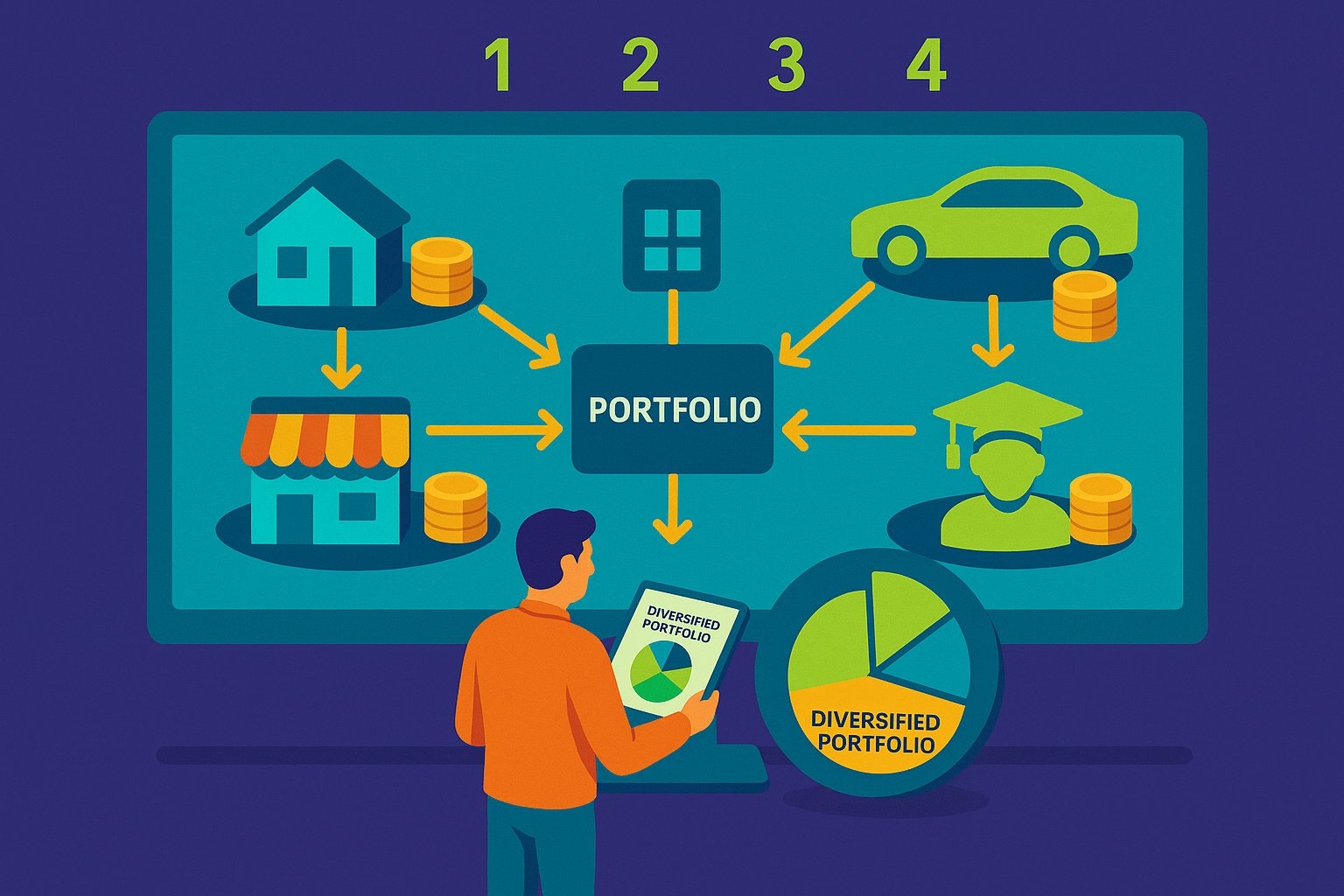The Relationship Between Credit Scores and Crowdfunding Success
In today’s digital age, crowdfunding has opened doors to countless entrepreneurial dreams and community projects, mobilizing capital at a pace unseen in traditional finance. Yet behind every successful crowdfunding campaign lies a critical indicator of borrower reliability: the credit score. For investors navigating the complex world of peer-to-peer lending or small-business crowdfunding, understanding how credit scores shape borrower risk profiles is just as essential as evaluating business plans or marketing strategies. Credit scores provide a window into a borrower’s creditworthiness—revealing patterns of payment behavior, historical delinquencies, and debt management habits. As crowdfunding platforms increasingly integrate credit scoring models into their risk assessments, the interplay between a borrower’s score and the investment’s potential return becomes undeniable. In this deep dive, we explore how credit scores operate, their impact on crowdfunding campaigns, and what savvy investors need to know to optimize returns while minimizing default risk. Strap in for an illuminating journey that demystifies credit scores and uncovers the secrets to making informed crowdfunding decisions.
Demystifying Credit Score Fundamentals
At its core, a credit score is a numerical representation of an individual’s credit history and predicts the likelihood of timely debt repayment. Typically ranging from 300 to 850, this three-digit number is computed using factors such as payment history, credit utilization, length of credit history, types of credit in use, and recent credit inquiries. Payment history—constituting roughly 35 percent of the score—highlights how punctually borrowers settle bills, whether mortgages, auto loans, or credit cards. Credit utilization examines the ratio of outstanding balances to total available credit, influencing about 30 percent of the score. Length of credit history, which accounts for around 15 percent, measures how long accounts have been open, rewarding those who maintain established lines of credit. The diversity of credit—encompassing installment loans, revolving lines, and mortgages—contributes another 10 percent, while recent inquiries and new accounts complete the profile. By digesting these components, investors can appreciate how lending decisions ripple through a borrower’s credit dossier, shaping scores that ultimately guide crowdfunding platforms’ risk-filtering mechanisms.
Beyond the Basics: Exploring Credit Scoring Models
Although the term “credit score” is often used generically, several scoring models coexist, each with its unique algorithmic nuances. The most widespread is the FICO® Score, developed by the Fair Isaac Corporation. FICO versions—such as FICO 8 or FICO 9—adjust weightings on factors like collections and small-balance write-offs, subtly altering borrower assessments. In recent years, alternative scoring systems like VantageScore, created by the three major credit bureaus, have gained traction among lenders. While VantageScore also ranges from 300 to 850, it places a stronger emphasis on recent payment behavior and allows scoring for individuals with shorter credit histories. Some newer platforms even integrate machine-learning algorithms that incorporate non-traditional data—such as utility payments or rental histories—to evaluate borrowers without extensive credit track records. For crowdfunding investors, recognizing these model differences is crucial; a borrower with a 700 FICO score might boast an equivalent 720 VantageScore, coloring risk perceptions in distinct ways. By staying attuned to these underlying scoring mechanics, investors unlock a more nuanced lens for analyzing borrower profiles across platforms.
How Borrower Credit Profiles Shape Crowdfunding Campaigns
In crowdfunding ecosystems, platforms rely on credit scores to categorize borrowers into risk tiers, influencing the interest rates assigned to each campaign. When a small business owner seeks funding to launch a new product line, the platform’s underwriting team reviews their credit report, along with financial statements and cash flow projections. A robust credit score signals timely past payments, translating into a lower perceived risk for investors. Consequently, that borrower might receive a more favorable interest rate, attracting more backers. Conversely, entrepreneurs with blemished credit histories—perhaps due to past bankruptcies or high utilization ratios—face steeper interest charges or even rejection from certain platforms. Investors scrolling through available loan listings will note these risk grades reflected in projected yields; a borrower with a sub-650 credit score might offer higher returns, but the elevated default probability necessitates caution. Understanding how credit metrics drive campaign structuring allows investors to calibrate their appetite: whether to chase higher yields by funding lower-rated borrowers or prioritize stability through prime-grade loans with modest returns.
Risk-Return Tradeoffs: Balancing Yield with Creditworthiness
The allure of crowdfunding’s attractive interest rates can be irresistible: some borrowers with mid-tier credit scores offer double-digit returns to entice investors. However, such eye-catching yields come at the cost of heightened default risk. As a rule of thumb, credit tiers fall into broad categories: prime borrowers—those scoring above 700—tend to present minimal default probabilities, translating into average interest rates in the high single-digit range. Near-prime borrowers, with scores between 650 and 699, shoulder slightly elevated risk, compensated by mid-teens interest rates. Subprime ventures, often scoring below 650, promise the most lucrative returns—sometimes over 20 percent—but the historical default rates for these categories can exceed 10 or even 15 percent annually. Striking the optimal risk-return balance involves diversifying across credit tiers: for instance, allocating 50 percent of funds toward prime borrowers for stability, 30 percent toward near-prime for moderate yields, and 20 percent toward subprime for potential upside. Such calibrated approaches help cushion the portfolio when inevitable borrower defaults occur, ensuring that occasional losses don’t obliterate gains from safer bets.
The Domino Effect of Poor Credit: Defaults and Principal Erosion
When a borrower defaults on a crowdfunding campaign, the consequences ripple far beyond a single missed payment. Debt restructuring, collection efforts, or legal recovery processes can extend over months or even years—during which the investor’s principal remains at risk. Defaulted loans with low or non-existent collateral pose the gravest threat; prime real estate loans might allow partial recovery through property sales, but unsecured personal or small business loans often yield minimal recoupment. Credit scores serve as the initial warning signals: a borrower with a pattern of 30- and 60-day delinquencies over the past year carries a higher probability of default than one with a pristine payment record. Furthermore, late payments often trigger negative credit events, exacerbating the borrower’s score decline and narrowing options for refinancing or loan consolidation down the road. As defaults accrue, a compounding effect emerges: recovering a fraction of each defaulted principal cannot match the time value of consistent interest earnings. Understanding the domino-like ramifications of poor credit profiles motivates investors to scrutinize credit histories meticulously, reducing exposure to borrowers whose scores narrate a troubling past.
Credit Score Trends: Foresight in a Shifting Economic Landscape
Credit scores do not exist in a vacuum; they ebb and flow in response to macroeconomic conditions such as unemployment rates, consumer sentiment, and interest rate shifts. During periods of economic expansion, job security tends to buoy timely payments, leading to gradual upticks in overall credit health. Conversely, recessions, rising costs of living, or industry-specific downturns often precipitate spikes in delinquencies and bankruptcies, dragging average scores downward. For crowdfunding investors, monitoring these broader credit score trends provides invaluable foresight. If a region experiences mass layoffs due to local factory closures, borrowers from that area—regardless of historical credit strength—may find themselves teetering on delinquency. Likewise, industry-specific shocks—such as sudden declines in retail foot traffic—can signal impending distress among small businesses reliant on brick-and-mortar revenues. By tracking unemployment data, regional economic indicators, and sector analyses, investors can adjust their risk filters temporarily, avoiding overexposure to susceptible borrower cohorts. Adopting this macroprudential mindset transforms credit scores from static snapshots into dynamic signals guiding prudent investment decisions.
Raising the Bar: How Improved Credit Scores Fuel Crowdfunding Potential
On the flip side of default concerns lies the transformative power of credit score improvement. Crowdfunding borrowers—especially entrepreneurs or nonprofits—who actively work to bolster their credit profiles reap direct benefits: lower interest rates, larger funding thresholds, and broader platform access. Simple measures like paying down revolving balances, disputing erroneous items on credit reports, and maintaining on-time payments can drive significant score gains within months. When a borrower’s score climbs from 620 to 680, for instance, platforms may reclassify them from subprime to near-prime, slashing their interest rate by several percentage points. Such improvements not only expand borrowing opportunities but also inspire investor confidence, attracting higher contributions to a campaign. For investors, understanding the levers of credit enhancement provides a secondary layer of portfolio protection: supporting borrowers with clear credit improvement plans—perhaps even through advisory services—can integrate social impact with financial returns. Ultimately, fostering borrower credit health elevates the entire crowdfunding ecosystem, producing virtuous cycles of reliability and resilience.
Inside Crowdfunding Platforms: Decoding Credit Score Disclosures
Each crowdfunding platform implements credit score disclosures uniquely, presenting information in ways designed to inform—but not overwhelm—potential investors. Some marketplaces publish a borrower’s exact FICO or VantageScore, alongside a brief summary of payment history. Others employ proprietary “risk grades” (such as A, B, C tiers) that map loosely to score bands, leaving precise numerical values opaque. A few platforms even combine credit scores with supplemental metrics—like debt-to-income ratios or business revenue forecasts—to generate composite risk indicators. For investors, decoding these disclosures demands vigilance: reliance on a single grade or number risks obscuring hidden vulnerabilities. Instead of fixating on a borrower’s “A” rating, for instance, examine accompanying details: how many open credit lines do they maintain? Have they recently maxed out credit cards, elevating utilization ratios? Did the platform’s underwriting team note any anomalous data points, such as non-traditional income sources or recent credit inquiries? By interrogating the full credit narrative rather than a solitary score, investors glean richer insights into borrower reliability, enabling more nuanced portfolio allocation.
Crafting a Credit-Informed Diversification Strategy
Diversification remains the bedrock of any prudent investment strategy, and credit score insights can inform segmented allocation approaches. Instead of spreading funds evenly across all credit tiers, smart investors might adopt a “barbell” strategy: directing a core portion—perhaps 60 percent—toward high-credit-score borrowers who offer modest yields but negligible default risk, while deploying the remaining 40 percent into lower-score borrowers with higher interest rates to capture incremental returns. This deliberate weighting cushions the portfolio in turbulent times by anchoring it with stable, prime-grade loans while retaining exposure to growth-oriented, higher-yield opportunities. Geographic diversification can be layered on top of credit-based segmentation, ensuring that high-grade borrowers in one region do not share the same economic fate as mid-grade borrowers in another. By combining credit score stratification with geographic and sector considerations—such as funding a mix of tech startups, consumer loans, and property-backed lending—investors achieve sophisticated diversification that mitigates idiosyncratic risks and smooths overall return volatility.
Ethical and Regulatory Dimensions of Credit Scoring in Crowdfunding
While credit scores enable efficient risk-based pricing, they also raise ethical and regulatory questions in the crowdfunding arena. Implicit biases in credit scoring can disproportionately impact certain demographics—such as minorities or lower-income groups—leading to skewed risk assessments. Some emerging platforms strive to address these concerns by incorporating alternative data points, like rental payment histories or employment stability, to create more inclusive underwriting models. Regulators worldwide are increasingly scrutinizing credit scoring methodologies to ensure fairness and transparency. In the United States, the Equal Credit Opportunity Act and Fair Credit Reporting Act mandate that borrowers receive adverse action notices when denied credit, including the reasons behind the decision. Crowdfunding platforms must navigate these regulations carefully, furnishing clear disclosures on how credit scores influence lending decisions. For investors, awareness of ethical considerations underscores the importance of selecting platforms committed to equitable practices. By championing venues that blend robust credit assessments with fair access, investors help foster a more responsible, inclusive crowdfunding ecosystem where financial empowerment extends beyond privileged cohorts.
Embracing a Future Fueled by Credit-Aware Crowdfunding
As crowdfunding continues its rapid evolution—fueled by technological innovation and shifting borrower needs—credit scores will remain at the heart of underwriting processes. Advanced machine-learning models may soon refine credit scoring by integrating real-time transaction data, social network analyses, and predictive behavioral patterns, delivering hyper-accurate risk profiles. For investors, embracing this future requires staying informed about emerging credit analytics tools and platform enhancements. Cultivating relationships with platform representatives, attending industry webinars, and tracking academic research on alternative credit modeling can sharpen one’s competitive edge. More importantly, adopting a credit-aware mindset transforms investment approaches: rather than viewing credit scores as mere gatekeepers, savvy investors recognize their multifaceted role in shaping campaign viability, optimizing portfolio resilience, and driving positive borrower outcomes. By remaining vigilant, adaptive, and ethically grounded, investors position themselves at the forefront of a crowdfunding revolution—one where credit scores and human ingenuity intertwine to power community growth, entrepreneurial success, and robust financial returns.
The Final Word: Leveraging Credit Scores for Smarter Crowdfunding Investments
Understanding credit scores transcends rote memorization of numeric ranges or percentile brackets; it demands a holistic grasp of how payment histories, debt behaviors, and macroeconomic landscapes converge to shape borrower reliability. In the dynamic realm of crowdfunding, where stakes range from launching grassroots ventures to funding cutting-edge innovations, credit scores act as critical signposts guiding investor decisions. By decoding the subtleties of scoring models, scrutinizing platform disclosures, and constructing credit-informed diversification strategies, investors unlock the potential to generate compelling returns while stewarding responsible lending practices. As you embark—or refine—your crowdfunding investments, let the insights gleaned here serve as a roadmap to credit-oriented diligence. In doing so, you’ll not only elevate your portfolio’s performance but also contribute to an equitable, resilient crowdfunding ecosystem where financial opportunity empowers communities and bright ideas flourish.




